
Yasuhiro Omoto, University of California at Berkeley
(yomoto@nihongoweb.com)
Miyuki Fukai, Indiana University (mfukai@indiana.edu)
Keiko Schneider, Saboten Web Design/Albuquerque TVI (kschnei@sabotenweb.com)
This handout in print and on-line is copyrighted to Yasuhiro Omoto, Miyuki Fukai, Keiko Schneider 2002.
Motivation
Needs to identify the current situations of the use of computer and the Internet in Japanese classes. Is that "a great idea we can never use?" Is Japanese still difficult to use on computers bought in the US? Post-secondary institutions use more?
Starting from Northern California
The area must be cutting edge of information technology. Two Japanese teacher
organizations:
Northern California Japanese Teachers Association (NCJTA)
California
Association of Japanese Language Teachers (CAJLT)
Survey
The survey was sent out via US mail in December 2001 and was asked to mail back in January 2002. The use of US mail and avoidance of the Internet was intentional. We felt by asking and taking the survey via the Internet would limit the answers from only from those who are already comfortable with the Internet.
After a brief biographical information about the institution being taught, the survey questions address in three areas.
1) Teacher's environment for computing and Japanese capability, including technical support
2) Availability of computers at school for class use
3) Recommended sites and technology-related projects completed in class.
The survey is one-page long and we tried to make is as easy and least time-consuming as possible.
1. Operating system
We assumed Windows operating systems are used most commonly (98 and 2000) and then Mac Os 9.x would come next.
2. Exclusive use
We thought 20-30% has a computer they can use exclusively.
3. Japanese capability in word processing, email and web browsing
We thought more than half of teachers can do word processing, email and web browsing in Japanese.
4. Trouble-shooting/Technical support
When it comes to trouble-shooting, we guessed teachers are left with nobody to ask or depend on informal help from friends and family.
5. Type of connection to the Internet
We guessed most teachers access the Internet from home with modem connection.
6. Availability of facilities for class use
We thought less than half of the people say they have facility at school to use. Out of that, most people say they don't have enough computers for all students.
7. Types of projects conducted in class
We thought some tried reading activities on the web, email exchange.
Result
We have sent out 178 letters to Japanese educators in Northern California for our survey project and have received 47 answers. We have divided answers to three different categories in accordance with the teacherユs institution: Elementary school, Middle school and Post-secondary school. There are two teachers who teach both Middle school and Post-secondary instruction, so we counted them twice. Since the survey was in multiple-choice format, we allow teachers to choose more than one answer if necessary. Here is the result we have received.
Q2: Both Windows and Macintosh are widely used.

Q3:Almost 95% of the teachers have a computer for their exclusive use
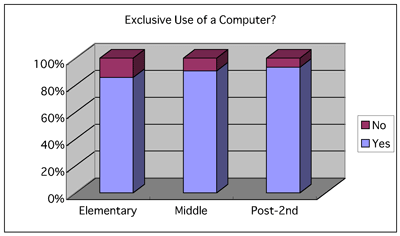
Qs 4, 5, & 6: Many of the teachers surveyed can do word processing, email and web browsing in Japanese, and they do use them actively; however, some still cannot do so.
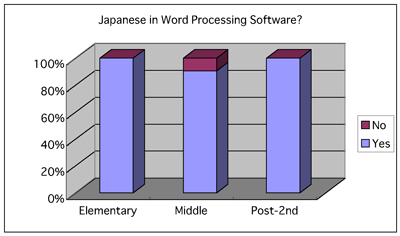


Q7: Family, friends, and colleagues at work are possible support source for trouble-shooting.

Qs 8&9: About half of the teachers connect most often from home; Half of them connect via modem.
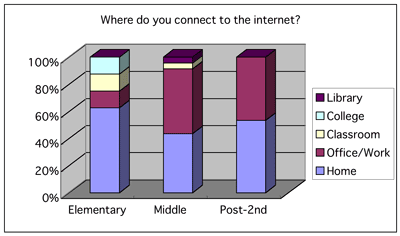

Qs 10&11: Computer access is available at school, but not enough for all students (particularly in pre-college level).
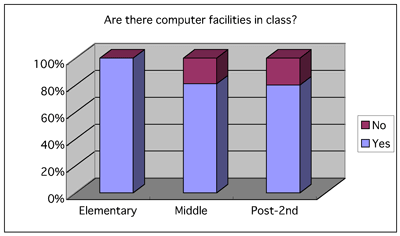
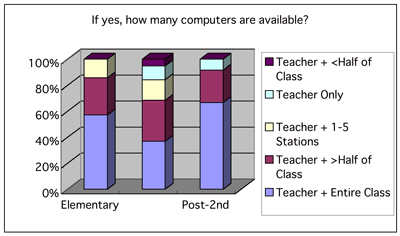
Qs 14&15: The teachers use email exchange projects and research projects with the Web information. Middle and high schools enjoy a variety of projects, while postsecondary schools transfer traditional assignments in electronic form (e.g., WebCT)
(O: our hypothesis is correct; X: our hypothesis is wrong; Mixed: our hypothesis is half correct, half wrong)
H1: Operating system (X)
Reasons: Macintosh has supported Japanese language with Japanese Language
Kit (JLK) since the early stage. Japanese language is easier to handle on Macintosh
than on Windows.
Implication: Application, software, and/or materials need to be cross-platform.
H2: Exclusive use (X)
Implication: Having an own computer makes it easier for the teachers
to seek for teaching resources on the Internet.
H3: Japanese capability in word processing, email and web browsing (Mixed)
Implication: Although we may be able to shift our focus from Japanese
capability issues to educational values of computers, we still need to address
issues regarding technical details so that Japanese teachers can lessen their
workload and assist their students who want to make their own computers Japanese
capable.
H4: Trouble-shooting/Technical support (O)
Implication: It is essential to build a community in which Japanese teachers
guide and support each other to facilitate the use of computers in Japanese
language education.
H5: Type of connection to the Internet (O)
Implication: We have to take it into consideration that delivery of large
audio and video files may be difficult or impossible at this stage, although
they are necessary for language instruction.
H6: Availability of facilities for class use (O)
Implication: It is necessary to develop more materials for small group
activities/tasks so that students can share a computer and participate in collaborative
learning.
H7. Types of projects conducted in class (Mixed)
Implication: To make the most use of these resources (e.g., reading newspapers
on the Web using an online dictionary), teachers may need training how to best
utilize authentic materials on the Web. They may also need to be encouraged
to explore possibilities of the Internet to achieve the five goals in the
National Standards for Foreign Language Leaning.
Q12 Please list web sites that you recommend to your fellow teachers for materials.
| Elementary | NihongoWeb http://www.nihongoweb.com/ Japanese Old Tales http://www.dl.ulis.ac.jp/oldtales/ |
| Middle/High School |
Japan Information Network |
| Postsecondary | Asahi Newspaper http://www.asahi.com/ NihongoWeb http://www.nihongoweb.com/ Yahoo Japan http://yahoo.co.jp/ Larry Stockton: Links to Japan http://ww2.lafayette.edu/~stocktoj/home/japanl.html Larry Stockton :Language & Education Links http://ww2.Lafayette.edu/~stocktoj/home/japan_lang.htm |
Q13 Please list web sites that you recommend to your students for self-study.
| Elementary | Asahi Newspaper http://www.asahi.com/ |
| Middle/High School | The Japan Forum http://www.tjf.or.jp/eng/indexe/indexe.htm Kids web Japan http://jin.jcic.or.jp/kidsweb/ http://www.jinjapan.org/kidsweb/ Rikai.com http://www.rikai.com/ Keiko Schneider's Bookmarks http://www.sabotenweb.com/bookmarks/ Mrs. Martin's page http://www.geocities.com/simmons_michelle/ Shodouka http://web.shodouka.com/ Reading Tutor http://language.tiu.ac.jp/ |
| Postsecondary | Asahi Newspaper http://www.asahi.com/ Genki Online http://genki-online.com/ JIN City http://www.jin.ne.jp/ Jim Breen's WWWJDIC Server http://www.csse.monash.edu.au/cgi-bin/cgiwrap/jwb/wwwjdic Larry Stockton: Links to Japan http://ww2.lafayette.edu/~stocktoj/home/japanl.html Larry Stockton :Language & Education Links http://ww2.Lafayette.edu/~stocktoj/home/japan_lang.htm |
Q14 Please list web sites you use in class.
| Elementary | ePals http://www.epals.com/index_jp.html |
| Middle/High School | Thurgood Marshall Academic High School: Japanese Reviewing site http://come.to/japanesewebsite The Japan Forum http://www.tjf.or.jp/eng/indexe/indexe.htm http://www.google.com/ Rikai.com http://www.rikai.com/ Mrs. Martin's page http://www.geocities.com/simmons_michelle/ Shodouka http://web.shodouka.com/ |
| Postsecondary | WebCT (corporate site for information) http://www.webct.com/ Yahoo Japan http://yahoo.co.jp/ Lipton sensei's Japanese class page http://www.Stanford.edu/class/japanese7b/ (8b, 9b etc) |
copyright 2002 Yasuhiro Omoto, Miyuki Fukai, Keiko Schneider